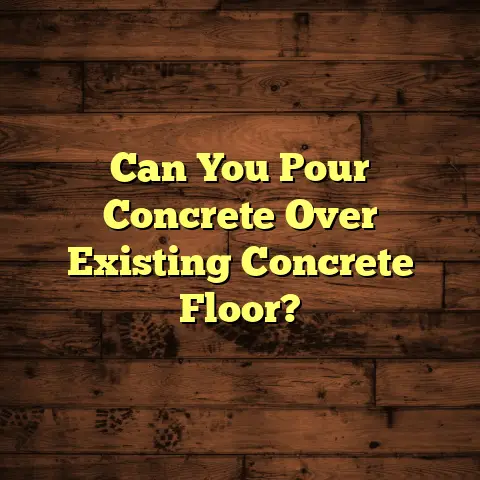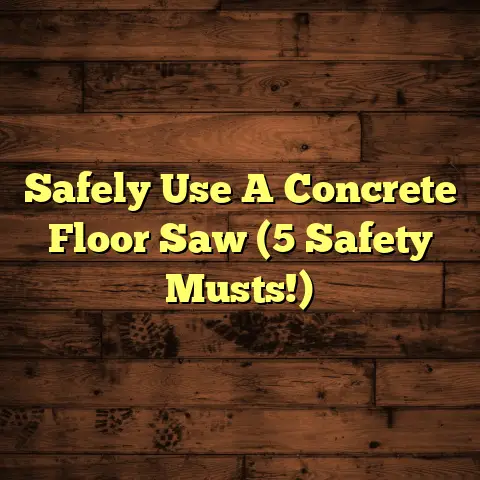Tile Over Existing Floors? (4 Costly Errors!)
Imagine stepping into your home after a long day.
The comforting familiarity of your living space wraps around you.
You walk across the floor, and your feet sink slightly into the plush carpet.
Or perhaps you feel the cool, hard surface of hardwood beneath you.
The flooring sets the tone for your entire home.
It acts as the foundation of your interior design.
But what happens when that flooring begins to show its age?
You might consider a quick fix: tiling over your existing floors.
It seems like a simple solution.
An effortless way to upgrade your space without the hassle of tearing everything out.
However, this seemingly straightforward endeavor can lead you down a path.
A path of costly errors and unforeseen complications.
As a flooring contractor with years of experience, I’ve seen it all.
I’ve witnessed firsthand the disastrous results of cutting corners.
The allure of saving time and money is strong.
But trust me, doing it right the first time is always cheaper in the long run.
In this article, we will explore the four most common and costly mistakes.
Mistakes homeowners make when opting to tile over existing floors.
From improper preparation to overlooking essential structural considerations.
These pitfalls can turn your dream renovation into a nightmare.
So, let’s dive in and learn how to avoid these common errors!
Section 1: The Allure of Tiling Over Existing Floors
Let’s be honest, the idea of tiling over existing floors is incredibly appealing.
Why tear out that old linoleum when you can just slap some beautiful new tile on top?
It promises time savings, reduced labor costs, and minimal disruption to your daily life.
Who wouldn’t want that?
DIY renovations are more popular than ever.
Thanks to social media platforms like Instagram and Pinterest.
We’re constantly bombarded with stunning before-and-after transformations.
These projects often make tiling over existing floors seem like a breeze.
But these images rarely show the full picture.
They often omit the crucial preparatory steps and potential problems.
According to a recent study by HomeAdvisor, homeowners spend an average of \$1,400 on flooring projects.
This includes both materials and labor.
The desire to keep costs down is understandable.
But neglecting to address underlying issues can lead to significant problems.
Problems that can easily double or triple your initial investment.
Think of it this way: you wouldn’t build a house on a shaky foundation, would you?
The same principle applies to tiling.
Your existing floor is the foundation for your new tile.
And if that foundation is flawed, your tile job is doomed from the start.
Section 2: Costly Error #1 – Ignoring the Condition of the Existing Floor
This is where I see most homeowners go wrong.
They’re so eager to get the new tile down.
They completely ignore the condition of the existing floor underneath.
This is like putting lipstick on a pig.
It might look better for a little while.
But the underlying issues will eventually surface.
Before you even think about buying tile, you need to thoroughly assess the condition of your existing floor.
Look for signs of damage, such as warping, moisture issues, or uneven surfaces.
-
Warping: Is the floor visibly bowed or uneven?
This could indicate moisture damage or structural problems. * Moisture Issues: Are there any stains, discoloration, or signs of mold or mildew?
These are red flags that need to be addressed immediately. * Uneven Surfaces: Does the floor feel level when you walk across it?
Even minor imperfections can cause tiles to crack or become uneven over time.
Here’s a personal story: I once worked on a project where the homeowner had tiled over existing vinyl flooring in their bathroom.
The vinyl looked fine on the surface, but underneath, there was significant water damage from a leaky toilet.
Within a few months, the new tile started cracking and lifting.
We had to tear everything out.
Rip out the new tile, remove the damaged vinyl, repair the subfloor, and start from scratch.
The homeowner ended up spending three times more than they would have.
Had they addressed the moisture issue before tiling.
Ignoring these signs can lead to costly repairs and replacements down the line.
It can also create a breeding ground for mold and mildew.
This can pose serious health risks to you and your family.
According to the Environmental Protection Agency (EPA), mold can cause a variety of health problems.
Including allergic reactions, asthma attacks, and respiratory infections.
Don’t take the risk.
Take the time to properly assess the condition of your existing floor.
If you’re not sure what to look for, hire a professional flooring contractor to do an inspection.
It’s a small investment that can save you a lot of money and headaches in the long run.
Section 3: Costly Error #2 – Skipping the Necessary Preparatory Steps
Okay, so you’ve assessed your existing floor.
You’ve determined that it’s in relatively good condition.
That doesn’t mean you can just start slapping tile down.
There are still several essential preparatory steps you need to take.
Skipping these steps is like trying to bake a cake without mixing the ingredients properly.
The end result will be a disaster.
These steps include:
-
Cleaning: Thoroughly clean the existing surface to remove any dirt, dust, grease, or wax.
I recommend using a degreasing cleaner specifically designed for flooring. * Leveling: If the floor is uneven, you’ll need to level it using a self-leveling compound.
This will create a smooth, even surface for your tile. * Priming: Apply a primer to the existing surface to improve adhesion.
This will help the tile adhesive bond properly.
The type of underlayment and adhesive you use is also crucial.
You need to choose products that are specifically designed for the type of flooring you’re tiling over.
For example, if you’re tiling over concrete, you’ll need to use a different adhesive than if you’re tiling over plywood.
Using the wrong underlayment can lead to a number of problems.
Including tiles cracking, lifting, or not adhering properly.
I remember another project where a homeowner tiled over existing hardwood flooring without using a proper moisture barrier.
The hardwood absorbed moisture from the tile adhesive.
This caused it to swell and warp.
The tiles started popping up within weeks.
We had to rip everything out and replace the hardwood subfloor.
The homeowner ended up spending thousands of dollars more than they had originally budgeted.
According to the Tile Council of North America (TCNA), proper surface preparation is essential for a successful tile installation.
They recommend following the manufacturer’s instructions for all products used.
Don’t cut corners on these preparatory steps.
They’re essential for ensuring a long-lasting, beautiful tile job.
Section 4: Costly Error #3 – Overlooking Moisture Issues
Moisture is the enemy of any flooring installation.
Especially in areas like bathrooms and kitchens.
These are areas that are constantly exposed to water and humidity.
Overlooking moisture issues can lead to a host of problems.
Including mold, mildew, and structural damage.
It’s like inviting unwanted guests to a party.
They’ll cause chaos and leave a mess behind.
Before you tile over existing floors, you need to assess the moisture levels in the subfloor.
You can use a moisture meter to get an accurate reading.
If the moisture levels are too high, you’ll need to take steps to address the problem before tiling.
This might involve repairing leaks, improving ventilation, or installing a moisture barrier.
There are various types of moisture barriers available.
Including liquid-applied membranes, sheet membranes, and vapor barriers.
The type of moisture barrier you choose will depend on your specific situation.
It depends on the type of flooring you’re tiling over.
It depends on the level of moisture you’re dealing with.
Here’s a statistic that might surprise you: according to the Institute of Inspection, Cleaning and Restoration Certification (IICRC), even small amounts of moisture can lead to mold growth within 24-48 hours.
Mold and mildew can not only damage your flooring.
They can also pose serious health risks to you and your family.
Mold can trigger allergic reactions, asthma attacks, and other respiratory problems.
It can also produce toxins that can cause neurological damage.
I once worked on a project where a homeowner tiled over existing concrete in their basement without installing a proper moisture barrier.
The concrete was constantly damp.
This created a breeding ground for mold and mildew.
The homeowner started experiencing health problems.
Including chronic coughs, headaches, and fatigue.
They eventually had to move out of their home while we remediated the mold problem.
The remediation process was expensive and time-consuming.
It was a nightmare for the homeowner.
Don’t make the same mistake.
Take the time to properly address moisture issues before tiling.
It’s an investment in your health and the longevity of your flooring.
Section 5: Costly Error #4 – Neglecting to Account for Height Differences
This is an often-overlooked aspect of tiling over existing floors.
Adding tile over existing flooring will inevitably increase the overall height of the flooring.
This can create a number of problems if you don’t plan for it properly.
It’s like trying to fit a square peg into a round hole.
It’s not going to work without some modifications.
Potential issues that can arise from height discrepancies:
-
Door Clearance: Will the doors still be able to open and close properly?
You may need to trim the bottom of the doors to provide adequate clearance. * Transitions to Other Rooms: Will there be a significant height difference between the tiled area and the adjacent rooms?
This can create a tripping hazard. You may need to install transition strips to create a smooth transition. * Accessibility Challenges: Will the increased height of the flooring create accessibility challenges for people with mobility issues?
This is especially important to consider if you have elderly or disabled family members.
I once worked on a project where a homeowner tiled over existing hardwood flooring in their kitchen without accounting for the height difference.
The new tile was significantly higher than the hardwood flooring in the adjacent living room.
This created a tripping hazard.
The homeowner ended up having to install a large, unsightly transition strip.
This detracted from the overall aesthetic of their home.
Before you start tiling, you need to carefully measure the height of your existing flooring.
Then, calculate the additional height that the new tile will add.
Consider how this height difference will affect the surrounding areas.
Plan accordingly.
You may need to adjust the height of the subfloor in adjacent rooms.
Or you may need to install transition strips to create a smooth transition.
If you’re not sure how to plan for these considerations, consult with a professional flooring contractor.
They can help you assess the situation.
They can recommend the best course of action.
Don’t neglect to account for height differences.
It’s a small detail that can have a big impact on the overall success of your tiling project.
Conclusion: The Cost of Convenience
Tiling over existing floors can seem like a quick and easy way to upgrade your space.
It can save you time and money in the short term.
But as I’ve explained, it’s crucial to be aware of the potential pitfalls.
Ignoring the condition of the existing floor, skipping preparatory steps, overlooking moisture issues, and neglecting to account for height differences can all lead to costly errors and complications.
While convenience is appealing, taking shortcuts can lead to more significant expenses in the long run.
It can also compromise the structural integrity of your flooring.
It can even pose health risks to you and your family.
Approach your flooring projects with careful consideration and informed decision-making.
Do your research.
Consult with professionals.
Don’t be afraid to ask questions.
By taking the time to do it right, you can ensure that your home remains a sanctuary.
A sanctuary rather than a source of stress.
Remember, your floor is the foundation of your home.
Treat it with the respect it deserves.





